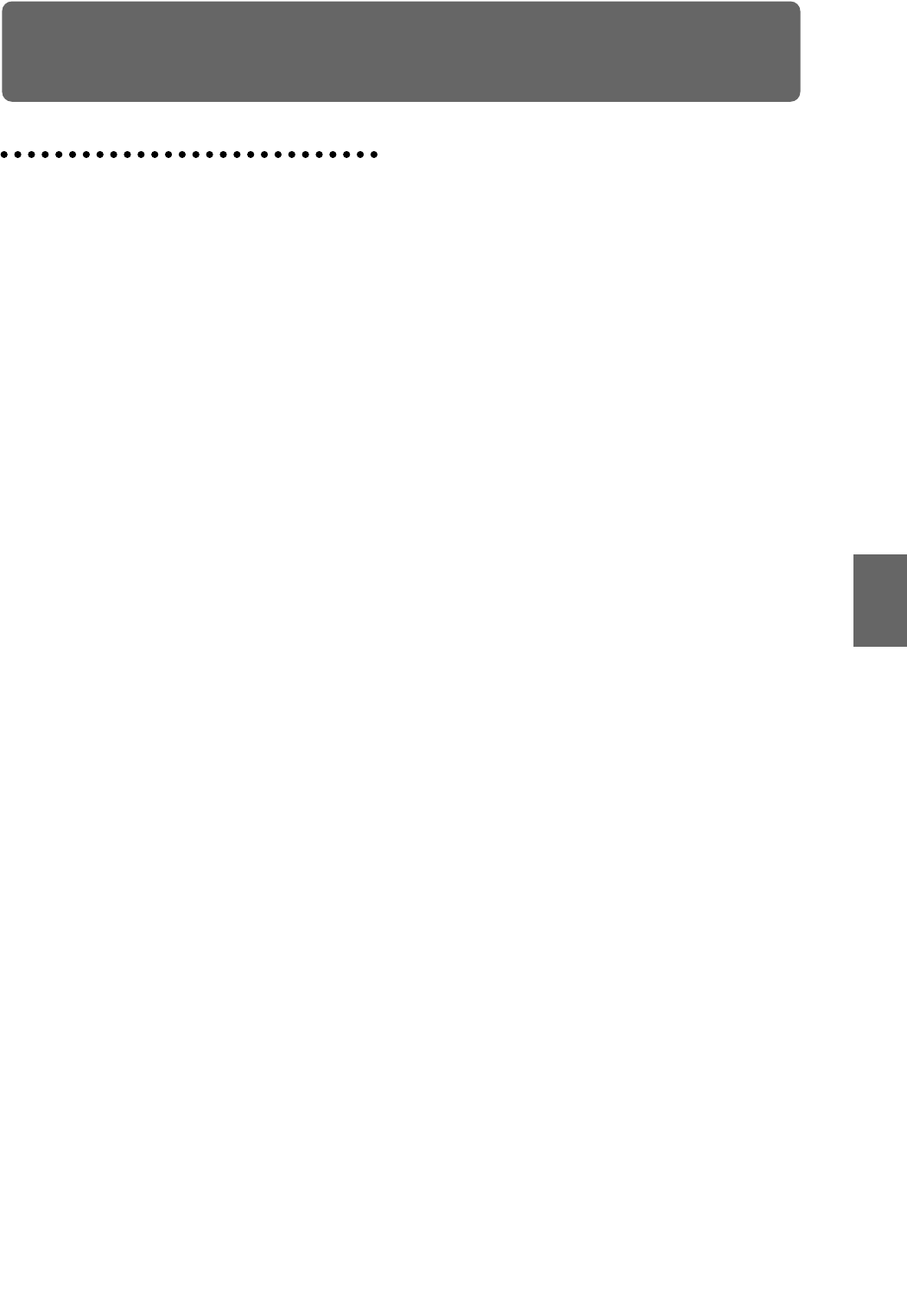
61
Sampling (Open Sampling System)
Features of sampling on the
TRITON Extreme
• The TRITON Extreme features our Open Sampling
System that lets you use sampling/resampling not
only in Sampling mode but also in Program,
Combination, and Sequencer modes, with
functionality optimized for the specific mode that you
are currently in.
• You can perform 48 kHz 16-bit linear mono or stereo
sampling.
• The TRITON Extreme is shipped with 16 Mbytes of
sample memory (RAM). When you sample, the data is
written into this sample memory (RAM) or to media.
(For details on the types of media you can use, refer to
p.137.)
The 16 Mbyte sample memory (RAM) allows approxi-
mately 2 minutes 54 seconds of mono sampling (or
approximately 1 minute 27 seconds of stereo sam-
pling). By installing 72-pin SIMM boards, you can
expand sample memory to a maximum of 96 Mbytes
(three 32 Mbyte SIMM boards; replacing the factory-
installed 16 Mbyte SIMM with a 32 Mbyte SIMM).
With the sample memory maxed out, the total sam-
pling time is 17 minutes 28 seconds of mono sampling
(approximately 8 minutes 44 seconds in stereo). How-
ever, because the TRITON Extreme RAM is addressed
as six individual 16 Mbyte banks, the maximum length
for any individual sample remains approximately 2
minutes 54 seconds (mono) or approximately 1 minute
27 seconds (stereo). Samples you record into sample
memory (RAM) can be used as tone generator wave-
forms. However, this data will be lost when the TRI-
TON Extreme’s power is turned off, so you must save
any sample data that you want to keep.
The Media lets you record up to 80 minutes as a single
sample file in either mono or stereo (monaural: approx-
imately 440 Mbytes, stereo: approximately 879
Mbytes). This will create a WAVE file.
If a sample (WAVE file) that was sampled to the media
is loaded into sample memory (RAM), it can be used as
a tone generator waveform. A sample (WAVE file) of
up to 16 Mbytes (mono) or 32 Mbytes (stereo) (if sam-
ple memory has been expanded to 32 Mbytes or
greater) can be loaded into sample memory (RAM).
You can create an audio CD by writing Wave files to a
CD-R/RW drive connected to the USB A connector.
•A maximum of 1,000 multisamples and 4,000 samples
can be created.
• In Media mode, you can load multisample/sample
data from various types of media.
• Korg format or Akai (S1000/3000 samples, mapped
multisamples only) format sample data, and AIFF or
WAVE format sample data can be loaded. (Once data
has been loaded into the TRITON Extreme, it will all
be treated as Korg format sample data.)
Sample data created on the TRITON Extreme can be
exported (output) as an AIFF or WAVE format sample
file.
• The external audio source that you are sampling can
be processed by the five insertion effect to apply
effects such as a compressor or EQ. The LFO
frequency or delay time of the effect can be specified
as a BPM value, which is highly effective when
sampling phrase loops etc.
(In Sampling mode, only the insert effects can be used.
In Program, Combination, and Sequencer modes, the
master effects can also be used.)
• You can apply Valve Force to the external audio
source you are sampling.
• Sampling can be initiated by the SAMPLING [START/
STOP] key, note-on, threshold, or the SEQUENCER
[START/STOP] key. (The available methods will
depend on the mode.) Threshold allows you to initiate
sampling when the input signal exceeds the threshold
level you specify. In Sampling mode, you can also
specify a pre-trigger setting.
• The analog audio inputs support mic and line level
signals. Digital audio input via S/P DIF IN supports
the 48 kHz sample rate.
• You can digitally sample (i.e., “rip”) audio data from
an audio CD in a CD-R/RW drive connected to the
USB A connector.
• Sampled data can be converted automatically (or
manually, using an easy operation) into a program
and used with the TRITON Extreme’s HI synthesis
system. (In Sampling mode, use “Convert MS To
Program.” In Program, Combination, or Sequencer
mode, use “Select Bank & Smpl No.”) Once a
multisample/sample has been converted into a
program, you can make filter, amp, and effect settings
and play it as a program. Such a program can also be
used in Combination mode or Sequencer mode.
Samples you record can also be used as drum samples
in a drum kit.
Sampling in Program, Combination, and Sequencer modes
•A performance in Program, Combination, or
Sequencer modes can be resampled internally, with all
audio remaining in digital form. This lets you
resample a performance that uses the TRITON
Extreme’s filters, effects, arpeggiator, and sequencer
etc.
• External audio sources from the various input jacks
can be sampled. A performance played on the
TRITON Extreme can be mixed with the external
audio source and sampled, or you can sample just the
external audio source while monitoring the
performance played on the TRITON Extreme. The
master effects can also be applied to the signal being
sampled.
• In Sequencer mode when you sample an external
audio source while listening to the playback of the
song, note data will be automatically created in the
track. This “In-Track Sampling” function lets you
sample vocals or guitar while you play the sequencer –
just as if you were recording on a multi-track recorder.
• Song playback in Sequencer mode can be resampled to
media. You can use Media mode to edit the song
order, and burn your songs to an audio CD in a CD-
R/RW drive connected to the USB A connector.
Program
Combination
SequencerSamplingSong PlayGlobalEffectMedia, etcPresetOther


















